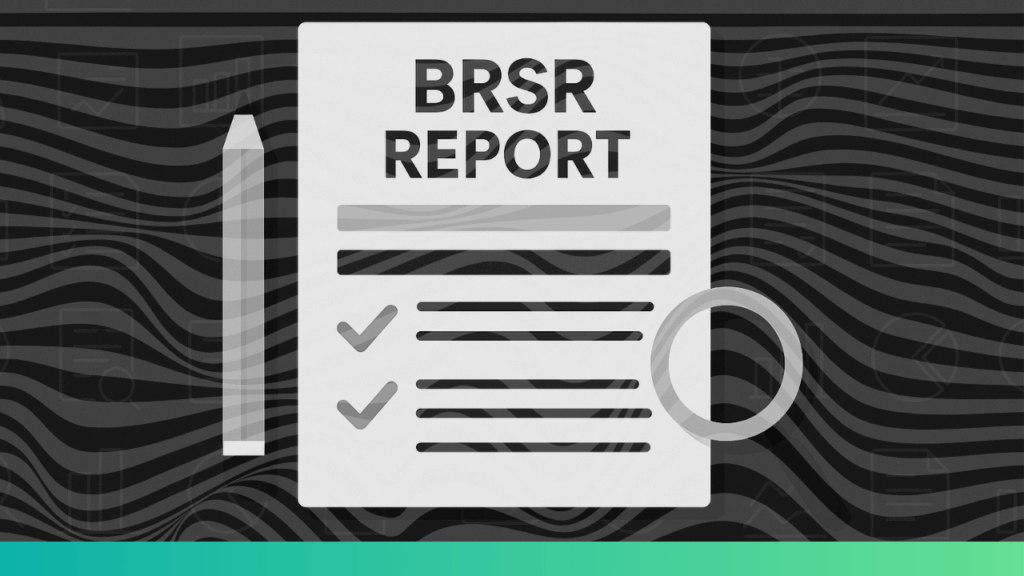A key component of corporate transparency in India’s changing ESG (Environmental, Social, and Governance) landscape is the Business Responsibility and Sustainability Report (BRSR). The Business Responsibility and Sustainability Report (BRSR), which has been mandated by SEBI for the top 1000 listed businesses since FY 2022–2023, focuses on approximately 1200+ data points, including quantifiable impact, stakeholder inclusion, and long-term sustainability data, it is important for the organisations to approach BRSR step by step.
As of 2024, more than 80% of these businesses have already begun to align their disclosures with international standards, including TCFD, SASB, and GRI. However, BRSR reporting represents a significant shift aimed at integrating sustainable and ethical principles into corporate India. The report condenses data points into a single report that covers almost all the departments of an organisation. Therefore, it is essential to adopt a strategic approach to filing a Business Responsibility and Sustainability Report (BRSR).
What is the BRSR step by step process?
Steps to follow while filing a BRSR report, according to the framework provided by SEBI:
Step 1: Identify all the data points
An organisation’s BRSR report contains over 1,200 data points across various departments, including management, finance, communication, human resources, and others. The first step in filing a BRSR report is to identify and locate all these data points within the organisation. There is a fixed format for the BRSR report prescribed by SEBI. An organisation can identify the necessary data by referring to the BRSR report format.
The BRSR report comprises various sections with multiple components.
Section A: General Disclosures
Components under this section are:
- Details of the listed entity: Name of the listed entity, year of incorporation, registered office address, reporting boundary, etc.
- Products/services: Details of business activities, products/services sold
- Operations: Number of locations, markets served, etc.
- Employees: Number of employees, and demographic details like differently abled, women’s participation ratio etc.
- Holding, Subsidiary and Associate Companies (including joint ventures)
- CSR Details
- Transparency and Disclosures Compliance
Examples of Section A of the BRSR report of JSW Steel Pvt. Ltd. 2023-2024
Section B: Management And Process Disclosures
This section is aimed at helping businesses demonstrate the structures, policies and processes put in place towards adopting the NGRBC Principles and Core Elements.
This section is Section B: Management and Process Disclosures of Business Responsibility and Sustainability Report (BRSR) format. It supports alignment with the National Guidelines on Responsible Business Conduct (NGRBCs). Here’s a breakdown:
Examples of Section A of the BRSR report of JSW Steel Pvt. Ltd. 2023-2024
Section C: Principle-Wise Performance Disclosure
This section is aimed at helping entities demonstrate their performance in integrating the BRSR Principles and Core Elements, which include key organisational processes and decisions. The information sought is categorized as “Essential” and “Leadership”. While the essential indicators are expected to be disclosed by every entity that is mandated to file this report, the leadership indicators may be voluntarily disclosed by entities that aspire to progress to a higher level in their quest to be socially, environmentally and ethically responsible. Here’s a look at the 9 Principles of BRSR.
Principle 1: Businesses should conduct and govern themselves with integrity, and in a manner that is Ethical, Transparent and Accountable.
Essential Indicators:
- % of Board, KMPs, employees, and workers trained on business responsibility.
- Fines/penalties paid; case details & appeals (if any).
- Anti-corruption policy in place? (Yes/No + link).
- Disciplinary actions for bribery/corruption (current & previous year).
- Conflict of interest complaints against Board/KMPs.
- Corrective actions taken on above issues.
Leadership Indicators:
- Training for suppliers/partners on ethical practices (% business covered).
- Conflict of interest management at the board level.
PRINCIPLE 2: Businesses should provide goods and services in a manner that is sustainable and safe
Essential Indicators:
- % of R&D and Capex spent on improving environmental/social impact.
- Sustainable sourcing procedures? (% of inputs sourced sustainably).
- End-of-life product recovery systems (plastics, e-waste, hazardous waste, etc.).
- Is Extended Producer Responsibility (EPR) applicable? Compliance with EPR plan?
Leadership Indicators:
- Life Cycle Assessments (LCA) done? (Product/service name, turnover %, public link).
- Key risks from production/disposal identified via LCA + mitigation actions.
- % of recycled/reused input materials (current & previous year).
- End-of-life waste data (in tonnes): reused, recycled, safely disposed (all waste types).
- % of reclaimed products/packaging by product category.
PRINCIPLE 3: Businesses should respect and promote the well-being of all employees, including those in their value chains
Essential Indicators:
- Welfare Coverage: % with insurance, maternity/paternity, daycare (by category).
- Retirement Benefits: PF, ESI, gratuity – coverage & deposits (Y/N).
- Accessibility: Premises accessible to persons with disabilities? (Y/N).
- Equal Opportunity Policy: As per disability law (link if applicable).
- Parental Leave: Return-to-work & retention rates.
- Grievance Redressal: Mechanism for all staff categories.
- Union Membership: % in recognised associations/unions.
- Training: Health/safety & skill training – % covered.
- Performance Reviews: % of employees/workers reviewed.
- Health & Safety System: In place? Hazard identification, medical access, etc.
- Safety Incidents: Injuries, fatalities, LTIFR data (FY-wise).
- Workplace Complaints: On safety/conditions – filed & pending.
- Assessments: % of sites reviewed for safety & working conditions.
- Corrective Actions: Actions on incidents/assessments.
Leadership Indicators:
- Life insurance/compensation for death? (Y/N)
- Statutory dues compliance by partners, Rehabilitation after incidents
- Transition support for exits
- Safety/work condition assessments of partners
- Corrective actions on partner risks
PRINCIPLE 4: Businesses should respect the interests of and be responsive to all their stakeholders
Essential Indicators:
- How stakeholders are identified
- List of key stakeholder groups
- Whether they’re vulnerable/marginalized
- Communication channels used
- Frequency and purpose of engagement
Leadership Indicators:
- How stakeholder feedback reaches the Board
- If/How feedback shapes policies
- Actions taken to address marginalized group concerns
PRINCIPLE 5: Businesses should respect and promote human rights
Essential Indicators:
- % of employees/workers trained on human rights, by type and year.
- Share of workforce paid at or above minimum wage, disaggregated by gender.
- Median pay by gender for board, KMPs, employees, and workers.
- Presence of a focal point handling human rights issues.
- Grievance redressal system for human rights complaints.
- Number of complaints on harassment, discrimination, child/forced labour, etc.
- Safeguards to protect complainants in sensitive rights cases.
- Human rights clauses included in contracts? (Yes/No)
- % of facilities assessed for key human rights risks.
- Corrective actions taken on risks found in assessments.
Leadership Indicators:
- Business processes changed due to human rights grievances.
- Human rights due diligence conducted and its scope.
- Premises accessible to differently abled visitors? (Yes/No)
- % of value chain partners assessed for rights issues.
- Actions taken to address supplier-level rights risks.
PRINCIPLE 6: Businesses should respect and make efforts to protect and restore the environment
Essential Indicators:
- Report total energy use and intensity.
- Disclose PAT scheme status and compliance.
- Share water use by source and intensity.
- Mention Zero Liquid Discharge adoption.
- Provide air emissions data (NOx, SOx, PM, etc.).
- Report Scope 1 & 2 GHG emissions and intensity.
- List GHG reduction projects.
- Total waste generated, reused, and disposed.
- Outline hazardous waste and chemical management.
- Disclose operations in eco-sensitive zones and compliance.
- List EIAs conducted and public disclosures.
- Mention environmental law violations and actions taken.
Leadership Indicators:
- Break down renewable vs non-renewable energy use.
- Share water discharge by destination and treatment. Report water use in water-stressed areas.
- Disclose Scope 3 emissions and intensity.
- Detail biodiversity impact in sensitive zones.
- Highlight green innovations and results.
- Disaster management plan.
- Note environmental risks in value chain and response.
- Indicate % of partners assessed for environmental impact.
PRINCIPLE 7: Businesses, when engaging in influencing public and regulatory policy, should do so in a manner that is responsible and transparent
Essential Indicators:
- List affiliations with trade/industry bodies and top 10 associations by reach.
- Disclose any anti-competitive cases and corrective actions taken.
Leadership Indicator:
- Share public policy positions advocated, methods used, and review frequency.
PRINCIPLE 8: Businesses should promote inclusive growth and equitable development
Essential Indicators:
- List SIAs conducted for projects, including disclosure and agency details.
- Disclose ongoing Rehabilitation & Resettlement (R&R) projects and PAFs covered.
- Describe community grievance redress mechanisms.
- Share percentage of input materials sourced from MSMEs/local producers.
Leadership Indicators:
- Detail corrective actions taken on negative social impacts from SIAs.
- Share CSR investments in aspirational districts.
- Report on procurement preference for marginalized/vulnerable groups.
- Disclose IPs based on traditional knowledge and benefit-sharing practices.
- Mention corrective actions in IP disputes involving traditional knowledge.
- Provide number of CSR beneficiaries, with % from vulnerable groups.
PRINCIPLE 9: Businesses should engage with and provide value to their consumers in a responsible manner
Essential Indicators:
- Describe consumer complaint and feedback redressal mechanisms.
- Share % turnover from products/services with info on ESG, safety, and disposal.
- Report consumer complaints by category (privacy, ads, delivery, etc.) for current and previous FY.
- List product recalls due to safety concerns—voluntary and forced.
- Indicate if there is a cybersecurity and data privacy policy.
- Detail corrective actions on advertising, data privacy, recalls, or regulatory penalties.
Leadership Indicators
- List platforms where consumers can access product/service info.
- Describe consumer education on safe/responsible product usage.
- Explain how consumers are informed about service disruptions.
- State if additional product info is displayed and if consumer satisfaction surveys were done.
- Share number of data breaches, their impact, and % involving personal data.
Each section has very specific qualitative and quantitative indicators. To manage the volume, many companies begin by creating a centralised compliance matrix, a live document that outlines which departments are responsible for what, and what systems currently track the required data.
Examples of Principle -wise disclosure of the BRSR report of JSW Steel Pvt. Ltd. 2023-2024
Also Read: BRSR reporting fundamentals every Indian company must know
Step 2: Do a materiality assessment
Topics that represent the organisation’s most significant impacts on the economy, environment, and people, including impacts on their human right is how the GRI standard defines material subjects. Materiality evaluation is the process used to determine these important subjects and their effects. To put it briefly, a topic (or priority area) or piece of information is deemed relevant if it affects stakeholders’ decision-making. Since for every company, not every sustainability indicator takes priority, Materiality assessment determines which Environmental, Social, and Governance (ESG) issues matter most to your business and its stakeholders.
In BRSR reporting, after identifying all the crucial data points that have to be added, conducting a materiality assessment is the second step. Once a company has gathered internal data on its environmental, social, and governance practices, the next task is to determine which sustainability issues are truly material—those that significantly impact the business and matter most to stakeholders. This step ensures that reporting efforts remain focused, relevant, and aligned with strategic priorities.
The materiality assessment involves the following steps:
- Engage stakeholders to understand ESG expectations through interviews or surveys.
- Analyze sector-specific risks using global frameworks like GRI, SASB, and CSRD.
- Benchmark peers to identify industry norms and unique gaps.
- Build a materiality matrix plotting business impact against stakeholder importance.
- Validate findings with leadership and review annually or as business conditions change.
By narrowing down the ESG topics that are most critical, the materiality assessment helps companies prioritize disclosures under the right BRSR principles and design effective sustainability strategies that resonate with both internal and external audiences.
Also Read: Are you making these 5 common BRSR report filing mistakes?
Step 3: Identify all the stakeholders and locations
Before diving into data collection, companies must first map their entire operational footprint—this includes not just corporate offices, but also manufacturing units, R&D centers, warehouses, logistics hubs, and even vendor sites. This geographic and functional mapping is essential for BRSR disclosures that require granular, site-specific data, especially under Principles 2 (Product Lifecycle Sustainability), 6 (Environment), and 8 (Inclusive Development).
It also enables more accurate reporting on topics like environmental compliance, local community engagement, and workforce diversity, including gender, caste, and socio-economic backgrounds at remote or rural locations. Stakeholder mapping is equally critical. BRSR asks companies to identify and disclose engagement with various stakeholder groups, such as employees, contract workers, suppliers, customers, regulators, and local communities. Each of these groups may face distinct issues, making it important to understand how business operations affect them differently.
Step 4: Collect the Data
After identifying data points, undergoing materiality assessment and mapping locations and stakeholders is to collect the data that was initially identified in Step 1. This step is often the most time-consuming and resource-intensive, especially for large or decentralized organizations. Many companies still lack centralized ESG data architecture, meaning sustainability metrics are often maintained in spreadsheets across multiple departments, making aggregation difficult and error-prone.
To streamline the process, organisations must assign clear responsibilities at the departmental level such as HR for workforce disclosures, EHS for environmental metrics, Legal for compliance-related data, and Procurement for supplier assessments. Defining KPIs (Key Performance Indicators), and clearly specifying data units and formats (e.g., kWh, tonnes CO₂e, % of diverse employees) can help bring consistency. Standardized templates, digital tools, or ESG software platforms (like The Sustainability Cloud) can help ensure consistency and version control.
Also Read: Diamond Power Infrastructure Ltd achieves 100% accuracy in BRSR compliance
Step 5: Consolidation of Data
After data is gathered, it needs to be combined and structured using the BRSR structure that SEBI has specified. This entails aggregating site-level data into KPIs for the entire firm, such as total emissions from Scope 1 and 2, total water used or recycled, and total workforce diversity. To guarantee year-over-year comparability and identify any notable changes or anomalies, companies must cross-check newly disclosed data with disclosures from prior years. To guarantee consistent benchmarking across time and against peers, many metrics such as GHG emissions per crore of revenue or per unit of output may need to be standardized.
In BRSR, narrative or qualitative disclosures are also very important. Businesses must explain their policies, procedures, stakeholder engagement initiatives, and the observable results attained in accordance with each of the nine principles. To ensure accuracy of information and consistency of voice, the corporate communication, policy, HR, and sustainability teams must work closely together.
Also Read: Top 5 must-have features of an ESG management software
Step 6: 3rd party audit
After the data has been consolidated into a BRSR report, the next step is the third-party assurance of BRSR data by a verification agency. Validating sensitive disclosures like emissions, workplace safety issues, or community investments can be aided by independent audits from reputable firms. Additionally, assurance improves the integrity of voluntary disclosures, which institutional investors and ESG rating organizations are increasingly monitoring.
Step 7: Format and send to SEBI
Compiling the report in the structured manner required by SEBI and include it in the company’s Annual Report that is sent to the stock markets (NSE/BSE) is the last phase in the BRSR process. Additionally, the report needs to be posted on the business’s website in a machine-readable and accessible format, ideally in a structured, searchable PDF or XBRL (Extensible Business Reporting Language). Since a large number of ESG grading systems extract information straight from public filings, this is essential for openness.
Companies should refrain from giving ambiguous or blank answers, like “NA,” without providing an explanation, in order to preserve compliance and credibility. Where data is available, they must include year-over-year comparisons and explicitly identify any assumptions or limitations in the methodology employed. This reduces the likelihood of regulatory scrutiny and increases trust in the report’s accuracy.
BRSR must be filed along with the Annual Report, typically within 60 days of the financial year’s end. Delays or non-compliance can attract penalties under SEBI’s Listing Obligations and Disclosure Requirements (LODR) Regulations.
How can digitisation help in BRSR reporting?
Digital technologies and integrated sustainability platforms can benefit organisations immensely as they start to streamline their sustainability operations. The appropriate solutions can reduce reporting complexity and free teams to concentrate on long-term ESG objectives rather than immediate administrative challenges by streamlining data collection, assisting with responsibility mapping, coordinating indicators with international frameworks, and monitoring policy compliance.
The Sustainability Cloud BRSR reporting software offers end-to-end reporting with features like 100% auditability, traceability and automated data collection. It offers integrated reporting by complying with other ESG reporting frameworks( BRSR, GRI, CSRD), climate disclosures and financial disclosures (SASB, IFRS S1 and S2, SFDR) as well, negating the need to incur costs for separate software.




